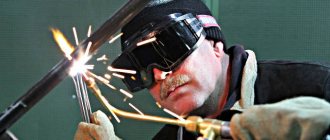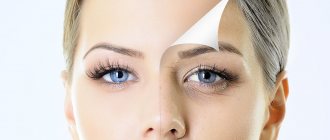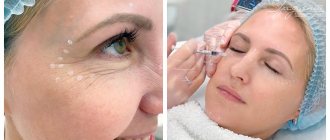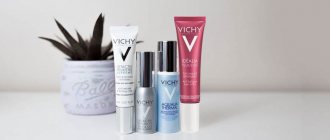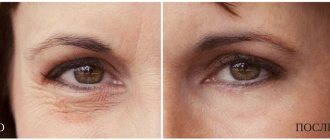Blepharoplasty (eyelid surgery) is an operation that involves lifting and removing excess skin and fatty tissue of the eyelids in order to improve the appearance of the area around the eyes, eliminate or reduce “bags” under the eyes, correct wrinkles and age-related changes.
The skin around the eyes is delicate, thin and very sensitive to negative influences. Due to the high muscle activity of this zone, the first age-related changes in the periorbital zone can be noticed after 25 years. Swelling of the area around the eyes, sagging skin and wrinkles, natural ptosis (drooping) of the eyelids, congenital or acquired defects significantly worsen the appearance and always add age to the face.
Blepharoplasty remains the most effective solution for correcting the periorbital zone. Not only middle-aged patients turn to eyelid surgery to correct age-related changes, but also young patients. The anatomical structure and congenital defects of the area around the eyes visually make the face much older and the look “tired.”
Indications for blepharoplasty
Main indications for eyelid plastic surgery:
- loss of tone and elasticity of the skin of the eyelids;
- tired look (“heavy” eyelids);
- drooping skin of the upper eyelid (“drooping eyelid”, including congenital eyelid ptosis);
- drooping (ptosis) of the lower corners of the eyes, as a result of which their shape changes and the size of the eyes decreases;
- excess skin of the lower eyelids, wrinkles, hernias, folds of the lower eyelids.
An eyelid lift allows you to get rid of excess skin and fatty tissue in the eyelid area, reduce signs of age-related changes, eliminate congenital and acquired eyelid defects, and correct the muscles of the periorbital area.
Chemical peeling
Peeling destroys dead cells of the upper layer of skin, actively stimulating skin renewal.
Indications:
- unwanted pigmentation;
- expression wrinkles;
- sagging lower and upper eyelids;
- covering scars and scars.
Contraindications:
skin diseases;- oncology;
- pregnancy;
- fresh wounds;
- individual intolerance to the chemical used.
pros:
- visual rejuvenation;
- relatively low cost;
- renewal of cells and tissues.
However, in this situation there are more disadvantages than advantages , namely a long healing period, pain, toxicity and a number of serious complications. Compared to blepharoplasty, peeling is just as dangerous (although the danger is of a different kind), the price is lower and it is possible to eliminate unwanted pigmentation.
| In Moscow | In St. Petersburg | |
| Average price (in rubles) | 300020000 | 1500-25000 |
Contraindications
Contraindications to blepharoplasty:
- difficult to correct dry eye syndrome;
- increased intraocular pressure;
- diseases of the cardiovascular system;
- diabetes;
- blood clotting disorder;
- acute viral diseases;
- acute infectious diseases (respiratory diseases, sore throat, pneumonia, etc.).
- diseases of internal organs (liver, kidneys, circulatory and endocrine systems, blood);
- chronic diseases in the acute stage.
Lymphatic drainage massage
The massage is aimed at improving the outflow of fluid through the lymphatic vessels. This helps maintain skin elasticity.
The procedure is recommended for:
reducing swelling;- destruction of facial wrinkles;
- improvement of blood vessels, cells;
- relieving excess tension from the eyes.
Contraindications:
- eye surgery performed earlier than 6 months ago;
- the presence of inflammatory processes;
- serious diseases (heart, liver, skin, endocrine system, etc.).
Pros of the procedure:
- reducing the amount of fluid and fat;
- even out skin color;
- further reduction of swelling;
- relatively low cost.
The disadvantages include the short effect of the procedure (you will have to repeat it regularly). Compared to blepharoplasty, massage must be repeated regularly, but it affects the color of the skin around the eyes and relieves tension (we talk about how long the effect of blepharoplasty will last here).
| In Moscow | In St. Petersburg | |
| Average price (in rubles) | 1.500-6.000 | 1.300-3.800 |
Upper blepharoplasty
Upper blepharoplasty allows you to get rid of excess and overhanging skin in the upper eyelid area. The so-called “drooping eyelid” effect is not only an aesthetic defect; due to the heaviness of the eyelids, vision deteriorates over time and the eyes become more tired.
In 90% of cases, during surgery, it is also important to remove excess fatty tissue in the upper eyelid area in order to make the look more youthful and open, and the face more attractive. Plastic surgery on the eyelids involves an incision along the natural skin fold of the upper eyelids, due to which the cosmetic seam remains completely invisible.
Eyelid correction can be performed simultaneously with surgery to eliminate the congenital pathology of eyelid ptosis. To achieve the best result and visible rejuvenation, upper blepharoplasty is performed in combination with lower blepharoplasty.
Reviews
Karina, 44 years old
I had trouble with my eyes; excess skin appeared on the upper eyelid, which literally poisoned my life. It got to the point where it became difficult for me to open my eyes in the morning. I flatly refused the operation that would help me get rid of this thing. I was very afraid of anesthesia, I had read too much about it.
I was browsing through the forums and came across a discussion about eyelid Thermage. I contacted a famous cosmetology clinic in Moscow that performs these procedures. It wasn't exactly cheap and required several procedures. But I really liked it, I don’t feel sorry for myself. First of all, it's very fast. He came on time, they processed you, and he left. It’s the same with my busyness. It’s hard for me to imagine that I’ll undergo surgery and then I don’t know what will happen. After a couple of months, the eyelids returned to almost normal. Let's see how long the effect lasts.
Lower blepharoplasty
Lower eyelid surgery is a surgical correction of the lower eyelid area, performed to eliminate congenital defects (the effect of “bags” under the eyes due to the structural features of the face) or to correct age-related changes.
By removing excess tissue and fatty tissue, lower eyelid blepharoplasty eliminates dark circles under the eyes and age-related changes, eliminates the effect of tired and puffy eyes, and makes the look younger and more expressive.
Lower blepharoplasty gives a more pronounced aesthetic result in combination with a general face lift and upper eyelid surgery.
Transconjunctival lower blepharoplasty
The essence of any of the eyelid plastic techniques comes down to one thing - the elimination of excess tissue in the eyelid area and the removal of periorbital hernias. The only difference is the method of performing the operation.
Plastic surgery on the eyelids requires extensive experience and high professionalism of the surgeon, because the eye area is a very delicate area. Therefore, the operation should be performed in such a way that after the operation the eyes look completely natural, without signs of interference. And transconjunctival blepharoplasty copes with this task flawlessly.
With this type of plastic surgery, the incision is made transconjunctivally, that is, through the conjunctiva (the mucous tissue covering the eyeball and the inner surface of the eyelids), so after transconjunctival blepharoplasty of the lower eyelids there are absolutely no traces left due to the absence of external incisions, the scar is located inside the lower eyelid and not requires stitches.
What is the difference between check-lifting and SMAS lifting?
SMAS lifting in combination with lower blepharoplasty is a more “heavy” method of lifting the middle zone and lower eyelids, which we today prefer to refuse for two reasons. Firstly,
these are two operations instead of one, and the SMAS lift is a much more traumatic and dangerous technique that requires up to 4 months of rehabilitation.
Secondly,
SMAS does not give such a natural effect as a check-lift (everyone knows how much the shape of the eyes sometimes changes after this type of lift). Distortion of facial features occurs due to the fact that during SMAS lifting, tissue displacement is carried out from the center to the periphery of the face, and during check-lifting, exactly in the direction from bottom to top. The latter is more correct if we remember that a lift should be carried out to correct age-related changes, which, on the contrary, shift the tissue from top to bottom.
Dr. Bely is confident that in the presence of midzone ptosis, checklifting surgery has practically no alternative, because if a patient with midzone ptosis undergoes conventional blepharoplasty, she will inevitably get an unwanted distortion of the shape of the eyes and/or hollows under the eyes due to the fact that “creeping » The tissues of the midface will inevitably pull the eyelid down.
To avoid this
, when planning plastic surgery for this area, you need to carefully and individually understand the real causes of the problems that have arisen and find out which correction method is indicated for you. It is necessary to keep in mind that not all plastic surgeons are proficient in the relatively new check-lifting technique. Some Moscow plastic surgeons are openly skeptical only because they have not yet fully mastered this method and are not confident that they will be able to succeed in performing this type of plastic surgery. Therefore, when choosing a surgeon and a technique, we recommend that you always follow the rule of “two opinions.” When planning blepharoplasty, consult at least two specialists and compare their opinions. At the same time, make sure that at least one of the plastic surgeons you choose is a specialist not only in blepharoplasty, but also knows the check-lifting technique.
Rehabilitation after blepharoplasty
On average, the operation can last from 40 minutes to 3 hours, depending on the scope of the intervention. The operation is performed under general anesthesia.
After the operation is completed, the patient, accompanied by relatives or close friends, goes home. The surgeon gives the patient individual recommendations, prescribes medications and a special diet. Recovery after blepharoplasty takes place at home.
Upper and lower eyelid surgery have the same rehabilitation conditions. During the postoperative period, the patient is recommended to sleep with his head raised high on the pillow and avoid tilting his head. There may be blurred vision and sensitivity to light, so it is recommended to wear sunglasses and relieve any strain on the eyes (reading, working with a computer, watching TV). It is not recommended to wear contact lenses for the first 2 weeks after surgery.
Bruises and swelling after surgery disappear within 1.5-2 weeks. In the absence of individual complications, an aesthetic appearance of the upper eyelids can be achieved already by the second week after plastic surgery.
Provided that the patient follows all the doctor’s recommendations, the results of blepharoplasty last up to 10 years. After this, if desired, the operation can be performed again.
Progress of the procedure
The procedure for correcting deficiencies in the periorbital area lasts, on average, 15-30 minutes. The specialist applies an anesthetic cream to the affected area. Then the mode and radiation power that is ideal for the patient are selected.
After the procedure is completed, the effect is immediately visible.
There may be slight swelling of the treatment area and redness of the skin. Experts recommend taking care of the treated area (applying compresses, applying special creams), and wearing sunglasses. Complete restoration of the skin occurs, on average, after 4-6 weeks.
The procedure can be performed at any time of the year, regardless of the patient’s age, skin type and color.
Advantages of the EMC Clinic
Plastic surgery on the eyelids includes a number of different correction options and requires the highest qualifications and precision from the specialist. Blepharoplasty at the EMC clinic is the best plastic surgery specialists with international practice and extensive practice, mastering the most complex methods of eyelid correction.
Innovative technical equipment, a modern fully equipped operating unit, the possibility of a comprehensive examination before surgery, and a postoperative hospital allow the EMC Aesthetic Clinic to maintain the highest level of medicine in Moscow.
Thermage
The procedure is based on the use of radio frequency radiation. It penetrates into the deep layers of the skin, affecting collagen fibers, causing them to shrink.
The result is a normalization of collagen levels, after which wrinkles are stretched and the skin is tightened.
The procedure is recommended for people to:
- visual opening (enlargement) of the eyes;
- eliminating the defect of the impending eyelid;
- strengthening the skin around the eyes;
- destruction of wrinkles.
Contraindications:
- age limit: 35-65 years;
- any eye surgery must be performed at least 6 months before the procedure;
- pregnancy;
- acute skin infection.
Pros of the procedure:
- the skin is not damaged;
- absence of pain;
- noticeable rejuvenating effect;
- lack of rehabilitation period.
The only downside is the high cost, which is not available to all clients . Compared to blepharoplasty, Thermage leaves no marks on the skin, is completely painless and there is no recovery period.
| In Moscow | In St. Petersburg | |
| Average price (in rubles) | 65000-105000 | 50000-85000 |
Photoexposure
The procedure is based on the impact of light pulses on the skin of the eyelids using a special apparatus. When in contact with the dermis, they eliminate many defects.
Indications:
- to increase skin elasticity;
- destruction of age spots;
- destruction of facial wrinkles;
- normalization of metabolic processes.
Contraindications:
- wounds, scratches;
pregnancy;- acute stage of chronic diseases;
- mental disorders;
- decreased immunity;
- skin diseases;
- taking medications that affect blood clotting.
pros:
- minimum risk of injury;
- short rehabilitation period;
- no pain;
- duration of effect.
Among the disadvantages we can note:
- high cost;
- the need to carry out the procedure several times.
The list of possible complications can also be scary (you can find out about possible complications after conventional blepharoplasty here). Compared to blepharoplasty, the procedure is more expensive, but without a long rehabilitation period, skin damage and pain.
| In Moscow | In St. Petersburg | |
| Average price (in rubles) | 3000-8000 | 1000-7000 |
Features of the laser resurfacing procedure
The laser beam, penetrating deep into the skin, is divided into many microbeams, which create pinpoint microscopic damage in the skin. In areas of damage, intensive recovery processes are launched, since the ability of skin tissue to regenerate is very high. The targeted effect provides a sufficient supply of healthy cells (that have not been exposed to micro-rays), which serve as a source for the creation of new collagen and elastin. At the same time, the skin significantly contracts and tightens - pinpoint areas of damage “evaporate” micro areas of the skin. Due to these processes, the skin of the eyelids is tightened and wrinkles around the eyes are smoothed out.
The principle of operation of threads
The process of implanting threads takes place with minimal risks and discomfort for patients. The result of this eyelid lift is characterized by high efficiency rates and long-lasting results.
Another name for the technique is vector technology. Biocompatible threads are implanted taking into account maximum tension and contraction of the skin, in a direction - vector, which is previously determined by a specialist. After inserting them under the skin, they create a kind of frame that reliably holds the skin in the chosen position and prevents it from sagging.
Aptos materials are characterized by strength and the specific shape of the notches on the threads. The presence of notches, verified by multiple clinical studies, allows you to retain tissue throughout the entire period that the thread is in the tissue. From the second day of their implantation, the active process of collagen production begins - a process that ensures the elasticity and strength of the skin. It lasts up to two months.
The formed frame in the local area increases the density of the skin and is fixed in the right place naturally. This allows you to maintain the results for at least one and a half years.
To correct small areas of the face (eyelids), short threads are used. Their implantation allows patients to rehabilitate in 2–3 days.
Injection method
The procedure involves injecting a liquid under the skin of the eyelids that absorbs fat and removes excess fluid.
Indications:
- to restore sagging eyelids;
- getting rid of dark circles;
- getting rid of wrinkles;
- raising the drooping corners of the eyes.
Contraindications:
- allergy;
- infections;
- eye diseases;
serious problems with the optic nerve;- pregnancy.
pros:
- short rehabilitation period;
- thinning of the fat layer;
- relatively low cost;
- small list of contraindications.
Among the disadvantages, you should pay attention to the discomfort during the procedure and an extensive list of possible complications. Unlike blepharoplasty, the procedure is safer , does not leave marks, and is suitable for more people due to a small list of contraindications.
| In Moscow | In St. Petersburg | |
| Average price (in rubles) | 15000-45000 | 10000-50000 |
Next you can watch a video about an injection alternative to blepharoplasty:
On our website you will find other publications about various methods and types of blepharoplasty. After reading them, you will learn:
- How do you prepare for surgery and how is it performed?
- What procedures are acceptable after blepharoplasty?
- What is circumferential blepharoplasty?
- What are the causes and consequences of unsuccessful surgery?
Features of the SMAS lifting procedure
The Ultroformer 3 device uses HIFU (High intensity focused ultrasound) technology - high-intensity focused ultrasound penetrates several levels of the skin and reaches the muscular aponeurotic layer (SMAS). Under the influence of ultrasonic waves, the temperature of soft tissues at a microthermal point at a given depth increases to 60–70°C.
Directed radiation triggers the processes of contraction and compaction of SMAS, tissue repair, lipolysis, and also activates collagen production. Thermal damage stimulates the synthesis of a new collagen matrix, the renewal of which is completed in 3–4 months.

